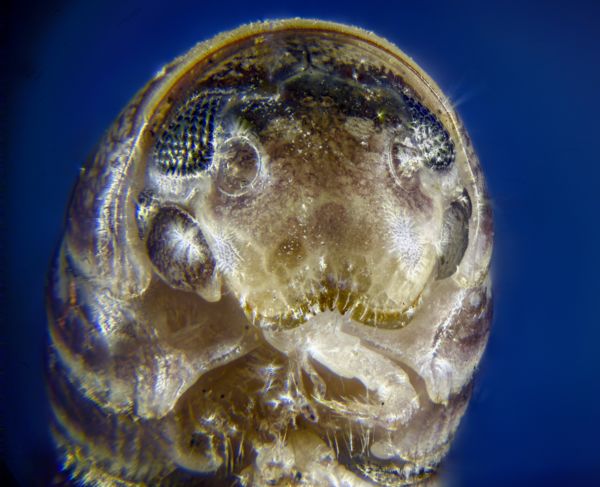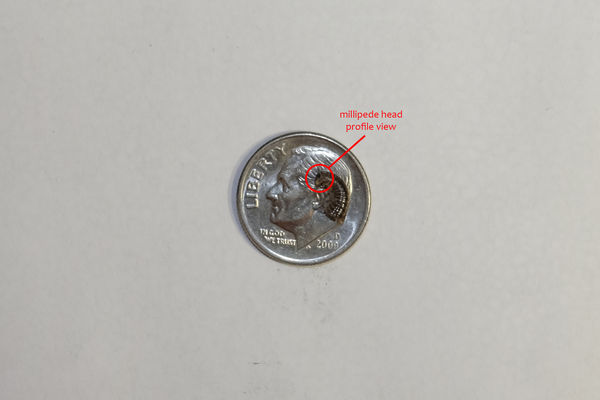Millipede Face
Jan 19, 2019 18:19:18 #
Earlier I posted my Millipede profile view which showed its beak-like mouth. This image is taken as a face-on view of it which was quite an effort to stage for it was so small and getting it into position but on a icy rain day there's nothing else to do.
I included a view of it laying on a dime in a profile view to give an idea of what this entailed shooting it face-on. It was quite departed and curled tight and stiff so this is a portion of its head end.
I included a view of it laying on a dime in a profile view to give an idea of what this entailed shooting it face-on. It was quite departed and curled tight and stiff so this is a portion of its head end.
Jan 19, 2019 19:27:09 #
sippyjug104 wrote:
Earlier I posted my Millipede profile view which showed its beak-like mouth. This image is taken as a face-on view of it which was quite an effort to stage for it was so small and getting it into position but on a icy rain day there's nothing else to do.
I included a view of it laying on a dime in a profile view to give an idea of what this entailed shooting it face-on. It was quite departed and curled tight and stiff so this is a portion of its head end.
I included a view of it laying on a dime in a profile view to give an idea of what this entailed shooting it face-on. It was quite departed and curled tight and stiff so this is a portion of its head end.
When blown up to an extreme some areas look like intergalactic stars and dust clouds.
When using the microscope lenses with a bellows I seem to get better fine tuning. The four power is somewhat forgiving. The ten not so. In looking at bristles on a fly, the depth of focus seems to be the thickness of a bristle or a bit more. Therefore, a stack program is the only answer to a clear photo.
To go much above ten would be futile? We'll see. Photomicrographic territory.
I now have some info learned buying bellows.
Honeywell, Pentax, Asahi. These names are on all five I have. They all have M42 screw in fittings. That makes it easy to adapt to a camera to M42 fitting. Mix and match parts. That means you can reverse lens stack, use diopters,
use microscope lenses and more with inexpensive fittings. It allows one to use a reversed lens of almost any make as the secondary lens.
Watch prices. A wide variation when it comes to used.
That said, what you found and your techniques leave nothing to be desired.
I just really like to tinker.
Bill
Jan 19, 2019 20:16:13 #
Bill, you are absolutely correct in your assessment of using a 10X power or higher microscope objective and it's depth of field being ultra razor thin.
Microscope objectives are listed with their "NA" value which is equivalent to a lens listing its maximum f-stop value. A standard 10X objective has an NA of 0.25 which is an f-stop equivalent of f-2.0 (a regular 4X has a NA of 0.10 which is equal to an f-4.0).
A difference of course is that the f-stop of a lens is adjustable whereas that of an objective is not. If you were to shoot your regular macro camera lens wide open to an f-2.0 it would produce a very, very shallow depth of field or an image so soft it would not be desirable for macro use which is why most use a setting between f-8 to f-16 in most cases.
Reverse lenses produce some mind-blowing detailed images and they need not be expensive lenses either and a lot of fellows use old photo enlarger lenses or scanner lenses that they use in a reverse configuration. With your bellows, tubes and assorted adapters your choices are many.
Microscope objectives are listed with their "NA" value which is equivalent to a lens listing its maximum f-stop value. A standard 10X objective has an NA of 0.25 which is an f-stop equivalent of f-2.0 (a regular 4X has a NA of 0.10 which is equal to an f-4.0).
A difference of course is that the f-stop of a lens is adjustable whereas that of an objective is not. If you were to shoot your regular macro camera lens wide open to an f-2.0 it would produce a very, very shallow depth of field or an image so soft it would not be desirable for macro use which is why most use a setting between f-8 to f-16 in most cases.
Reverse lenses produce some mind-blowing detailed images and they need not be expensive lenses either and a lot of fellows use old photo enlarger lenses or scanner lenses that they use in a reverse configuration. With your bellows, tubes and assorted adapters your choices are many.
Jan 20, 2019 10:28:37 #
Some news on this subject is that Bill will be sending me some gear, including a microscope lens, to adapt to my Canon camera. So I am sort of nudging into trying out this sort of photography. I don't have a rail, or as yet a defined source of external lighting, but I will see what I can do with what I have. At the very least I will gain a better appreciation at how challenging this sort of thing is. I do have a stacking software program called Focus which i had bought a while back on deep discount. Never tried it.
Jan 20, 2019 11:32:34 #
Mark, I'm eager to see the results of your venture into microscopic macro photography for you are already a master at what you do.
Through many experiments I've learned that a manual focus rail works very well at these magnification ranges. My first setup was quite simple for I mounted my camera on a 10-inch by 30-inch piece of 3/4-inch plywood which laid flat on my bench table and I put some weights on it (finally found a use for my old exercise equipment!). I drew a line down the center so that I had an axis to stage on.
With the camera firmly mounted in position there is only one thing left to control which was the subject. I found that it was easier to manipulate the subject on the focus rail than it was the camera and the process of a fixed focus and moving closer and closer taking a shot each time was the same but with far less vibration for sure. Shoot the camera with a remote trigger, set it in the Mirror Up mode, and set a 2-second delay between shots.
When moving the focus rail, imagine the knob is a clock face with twelve positions. Put a mark (dab of nail polish is what I used) on the knob and turn it 1/12th of a turn for each shot that you take.
My first attempts were putting the camera on a tripod but the slightest bump or touch would cause shake even though I had it weighted down. Plain and simple, the flat piece of plywood doesn't move.
Lighting method of your choice and I know that you have perfected your lighting skills. I used a studio strobe at first but with 100 or more shots to a stack, it overheated and would shut off so I went with constant lighting and an assortment of DIY diffusers. Far from perfect yet, but it's a constant work in progress for me.
Through many experiments I've learned that a manual focus rail works very well at these magnification ranges. My first setup was quite simple for I mounted my camera on a 10-inch by 30-inch piece of 3/4-inch plywood which laid flat on my bench table and I put some weights on it (finally found a use for my old exercise equipment!). I drew a line down the center so that I had an axis to stage on.
With the camera firmly mounted in position there is only one thing left to control which was the subject. I found that it was easier to manipulate the subject on the focus rail than it was the camera and the process of a fixed focus and moving closer and closer taking a shot each time was the same but with far less vibration for sure. Shoot the camera with a remote trigger, set it in the Mirror Up mode, and set a 2-second delay between shots.
When moving the focus rail, imagine the knob is a clock face with twelve positions. Put a mark (dab of nail polish is what I used) on the knob and turn it 1/12th of a turn for each shot that you take.
My first attempts were putting the camera on a tripod but the slightest bump or touch would cause shake even though I had it weighted down. Plain and simple, the flat piece of plywood doesn't move.
Lighting method of your choice and I know that you have perfected your lighting skills. I used a studio strobe at first but with 100 or more shots to a stack, it overheated and would shut off so I went with constant lighting and an assortment of DIY diffusers. Far from perfect yet, but it's a constant work in progress for me.
Jan 20, 2019 17:53:11 #
If you want to reply, then register here. Registration is free and your account is created instantly, so you can post right away.




